
A Look at Toronto's Biggest Transit Hub - by Ninjalicious

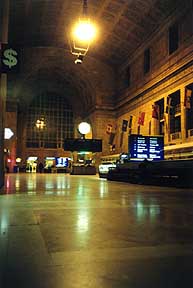 Like many sheltered kids from the suburbs around Toronto, I was given my first taste of the big city's architecture at Union Station. When I first emerged into Union Station's cathedral-like Great Hall, I had to struggle very hard to keep the proper degree of teenage aloofness in front of my friends. In truth, I was absolutely blown away by the sweeping façades, the beautiful monumental architecture I later learned to call "Beaux-Arts", and the sheer size of the thing, which seemed to dwarf even Pickering's Sheridan Mall. It was the biggest, prettiest and oldest building I'd ever seen.
Like many sheltered kids from the suburbs around Toronto, I was given my first taste of the big city's architecture at Union Station. When I first emerged into Union Station's cathedral-like Great Hall, I had to struggle very hard to keep the proper degree of teenage aloofness in front of my friends. In truth, I was absolutely blown away by the sweeping façades, the beautiful monumental architecture I later learned to call "Beaux-Arts", and the sheer size of the thing, which seemed to dwarf even Pickering's Sheridan Mall. It was the biggest, prettiest and oldest building I'd ever seen.Construction began in 1913, but the station was not officially opened until 1927. The massive building, which occupies an entire block on Front Street between York and Bay Streets, has been the largest and busiest rail station in Canada since its construction. In recent years, Union Station has taken on added importance in the Metropolitan Toronto area as the terminal for commuter trains, bus, rapid transit and subway systems.
TTC Station
Train Concourses
|
|
Under the Station Union Station is nice because it's so old and haphazard. I love seeing how the engineers have built around the original architecture, rather than simply demolishing it and starting fresh. It gives character. City planners could learn from this style of building. Among the best areas for spotting odd, out of place alcoves are the multiple levels under the station. The parking garages can be accessed either through a set of automatic glass doors at the end of a hallway branching off from the VIA section (just past the security office), or through ramps leading down from VIA's arrivals concourse, or from the GO Concourse, through an unmarked brown door in the hallway leading to tracks 12 and 13. I'll refrain from writing too much about the parking garages, because I know that most people don't get all worked up over parking garages the way I do, but these really are beauties. Several fascinating old relics abound, including very oddly-shaped ancient elevators, many unlocked mechanical rooms and supply rooms, and all sorts of bizarre equipment I lack the vocabulary to describe. The walls, floors and high ceilings are alternately built out of red brick, cement, steel, asphalt and painted wood, in no apparent pattern. Pedestrian and auto ramps lead up and down, and all the floors are on a decent slope. I don't think there is a level surface in the whole place. There are a couple of closed-circuit cameras in the garages, but they're easy to spot and avoid. Though no entrance to the garages is marked "staff only" or "do not enter", the garages are unquestionably employee-only territory, and there are usually a handful of employees down here who will see you. Fortunately, Union Station has a hell of a lot of employees, working for dozens of competing acronyms, so if you simply walk purposefully while checking your watch or fumbling with your car keys, you won't have any problems. 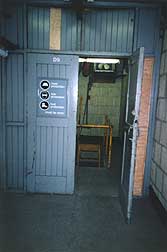 While the whole area is filled with explorable alcoves and storage rooms, there are two specific spots down here to seek out. The first is the area at the northeastern corner of the garages, which has entrances to the station's very interesting shops and mechanical rooms, including an engine room, an elevator room, a metal shop, a truck repair shop and a carpenter's shop. Providing that no employees are on duty, there is lots of stuff to peek at here.
While the whole area is filled with explorable alcoves and storage rooms, there are two specific spots down here to seek out. The first is the area at the northeastern corner of the garages, which has entrances to the station's very interesting shops and mechanical rooms, including an engine room, an elevator room, a metal shop, a truck repair shop and a carpenter's shop. Providing that no employees are on duty, there is lots of stuff to peek at here.The second is the entrance to the steam tunnels, which is quite easy to find if you just stare at the ceiling and follow the pipes. Or look for room D9 – the D stands for delivery level, I think. In a nondescript alcove, tucked behind a pair of wooden doors, is a steep metal staircase leading further underground.
Steam Tunnels
|
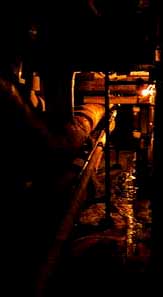 Mechanical Wonderland
Mechanical WonderlandThe inconspicuous little metal panel opened to reveal a further series of tunnels, rougher, wetter and more cramped than the main steam tunnels, which sloped down as we headed north. As well as the wet floor, occasional ladders leading up to street-level manholes give this area a drain-like quality. Eventually, the drain-like tunnels emptied out into a low-ceilinged crawlspace area. Unpleasant odours and an abundance of rat traps kept Victor and I from exploring all the dark tunnels branching off from this area. Instead we headed up a flight of stairs and emerged into an extremely large, high-ceilinged and unpopulated room filled with machinery, oddities and wonders. This, I realized, was Union Station's famous power substation. After the apocalypse, the smart money is on Union Station. There are self-contained carpentry, plumbing, electrical, machine and paint shops, and all sorts of tunnels and fun places to climb and play. On top of supplying the water and steam needs of itself and many of its large neighbours, Union's power substation is also capable of supplying the electricity needs of a good-sized town. 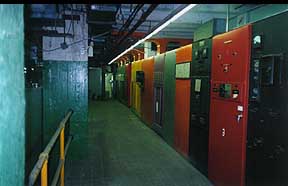 The first thing that struck me about the area was how cheerful it was, for an overgrown mechanical room. All the metal rails were painted bright yellow or bright green. A huge bank of machines was brightly decorated in all the colours of the rainbow. Yes, even indigo! For some reason, "machinist" and "interior decorator" are two items that rarely appear on the same resume, so this room was a strange sight.
The first thing that struck me about the area was how cheerful it was, for an overgrown mechanical room. All the metal rails were painted bright yellow or bright green. A huge bank of machines was brightly decorated in all the colours of the rainbow. Yes, even indigo! For some reason, "machinist" and "interior decorator" are two items that rarely appear on the same resume, so this room was a strange sight.Other tourist attractions in this area include the huge hole in one of the cement walls leading to a chamber underneath a street grate, a collection of several dozen small wooden chairs of the type used by kindergarten children, several smaller, more abandoned-looking rooms full of lifeless machinery, and a door leading into a large unlit area connected to the station's ventilation system. This gigantic ventilation area (behind the rainbow machines) offers all sorts of fun shafts to climb in, over, around and through, and is one of the station's biggest highlights. I wish some of my pictures had turned out. Make sure to bring a flashlight along, as the area has no lights whatsoever, and bring a stack of moist towellettes with which to clean yourself afterwards. We also discovered the hallway through which the employees enter the plant. Victor and I took the steam tunnel exit, though, because we were much too far from anywhere even vaguely public to have an excuse if we were caught.
The Great Hall
TTR Offices
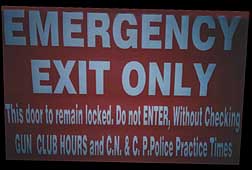
For my next trick, I made my way down to the basement level of the TTR offices. A couple of TTR employees were standing in a stairwell necking when I arrived, but they seemed content to ignore me. I found a rather insecure phone closet. I tried a few doors leading down to the steam tunnels but to my immense frustration they were locked. I exited out to the VIA Concourse through a door that locked behind me. Temporarily, anyhow. You can read about further Union Station adventures in my journal. A version of this article originally appeared in Infiltration 12 (February 1999), together with letters and articles on the Chicago Tunnel Company tunnels, Michigan Central Station and the Buffalo Central Terminal.
|